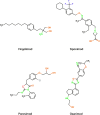The Role of Sphingolipids and Specialized Pro-Resolving Mediators in Alzheimer's Disease
- PMID: 33633739
- PMCID: PMC7902029
- DOI: 10.3389/fimmu.2020.620348
The Role of Sphingolipids and Specialized Pro-Resolving Mediators in Alzheimer's Disease
Abstract
Alzheimer's disease (AD) is the leading cause of dementia worldwide giving rise to devastating forms of cognitive decline, which impacts patients' lives and that of their proxies. Pathologically, AD is characterized by extracellular amyloid deposition, neurofibrillary tangles and chronic neuroinflammation. To date, there is no cure that prevents progression of AD. In this review, we elaborate on how bioactive lipids, including sphingolipids (SL) and specialized pro-resolving lipid mediators (SPM), affect ongoing neuroinflammatory processes during AD and how we may exploit them for the development of new biomarker panels and/or therapies. In particular, we here describe how SPM and SL metabolism, ranging from ω-3/6 polyunsaturated fatty acids and their metabolites to ceramides and sphingosine-1-phosphate, initiates pro- and anti-inflammatory signaling cascades in the central nervous system (CNS) and what changes occur therein during AD pathology. Finally, we discuss novel therapeutic approaches to resolve chronic neuroinflammation in AD by modulating the SPM and SL pathways.
Keywords: Alzheimer’s disease; bioactive lipids; ceramide; neuroinflammation; specialized pro-resolving mediator; sphingolipids; sphingosine-1-phosphate.
Copyright © 2021 de Wit, Mol, Rodríguez-Lorenzo, de Vries and Kooij.
Conflict of interest statement
The authors declare that the research was conducted in the absence of any commercial or financial relationships that could be construed as a potential conflict of interest.
Figures



Similar articles
-
Novelty of Sphingolipids in the Central Nervous System Physiology and Disease: Focusing on the Sphingolipid Hypothesis of Neuroinflammation and Neurodegeneration.Int J Mol Sci. 2021 Jul 8;22(14):7353. doi: 10.3390/ijms22147353. Int J Mol Sci. 2021. PMID: 34298977 Free PMC article. Review.
-
Control of inflammatory responses by ceramide, sphingosine 1-phosphate and ceramide 1-phosphate.Prog Lipid Res. 2016 Jan;61:51-62. doi: 10.1016/j.plipres.2015.09.002. Epub 2015 Dec 15. Prog Lipid Res. 2016. PMID: 26703189 Review.
-
Ceramide/Sphingosine 1-Phosphate Axis as a Key Target for Diagnosis and Treatment in Alzheimer's Disease and Other Neurodegenerative Diseases.Int J Mol Sci. 2022 Jul 22;23(15):8082. doi: 10.3390/ijms23158082. Int J Mol Sci. 2022. PMID: 35897658 Free PMC article. Review.
-
Sphingolipids in neuroinflammation: a potential target for diagnosis and therapy.BMB Rep. 2020 Jan;53(1):28-34. doi: 10.5483/BMBRep.2020.53.1.278. BMB Rep. 2020. PMID: 31818364 Free PMC article. Review.
-
The Novel Omega-6 Fatty Acid Docosapentaenoic Acid Positively Modulates Brain Innate Immune Response for Resolving Neuroinflammation at Early and Late Stages of Humanized APOE-Based Alzheimer's Disease Models.Front Immunol. 2020 Oct 16;11:558036. doi: 10.3389/fimmu.2020.558036. eCollection 2020. Front Immunol. 2020. PMID: 33178186 Free PMC article.
Cited by
-
Characterization of Hair Metabolome in 5xFAD Mice and Patients with Alzheimer's Disease Using Mass Spectrometry-Based Metabolomics.ACS Chem Neurosci. 2024 Feb 7;15(3):527-538. doi: 10.1021/acschemneuro.3c00587. Epub 2024 Jan 25. ACS Chem Neurosci. 2024. PMID: 38269400 Free PMC article.
-
Exploring the Dynamic Changes of Brain Lipids, Lipid Rafts, and Lipid Droplets in Aging and Alzheimer's Disease.Biomolecules. 2024 Oct 26;14(11):1362. doi: 10.3390/biom14111362. Biomolecules. 2024. PMID: 39595539 Free PMC article. Review.
-
Ceramide and Sphingosine-1-Phosphate in Neurodegenerative Disorders and Their Potential Involvement in Therapy.Int J Mol Sci. 2022 Jul 15;23(14):7806. doi: 10.3390/ijms23147806. Int J Mol Sci. 2022. PMID: 35887154 Free PMC article. Review.
-
Lipid-nanoparticle-induced vacuolization in microglia.Commun Biol. 2024 Nov 23;7(1):1558. doi: 10.1038/s42003-024-07271-6. Commun Biol. 2024. PMID: 39580571 Free PMC article.
-
Omega-3 supplementation attenuates doxorubicin-induced cardiotoxicity but is not related to the ceramide pathway.Food Sci Nutr. 2024 Sep 29;12(11):9198-9211. doi: 10.1002/fsn3.4492. eCollection 2024 Nov. Food Sci Nutr. 2024. PMID: 39620015 Free PMC article.
References
Publication types
MeSH terms
Substances
LinkOut - more resources
Full Text Sources
Other Literature Sources
Medical

